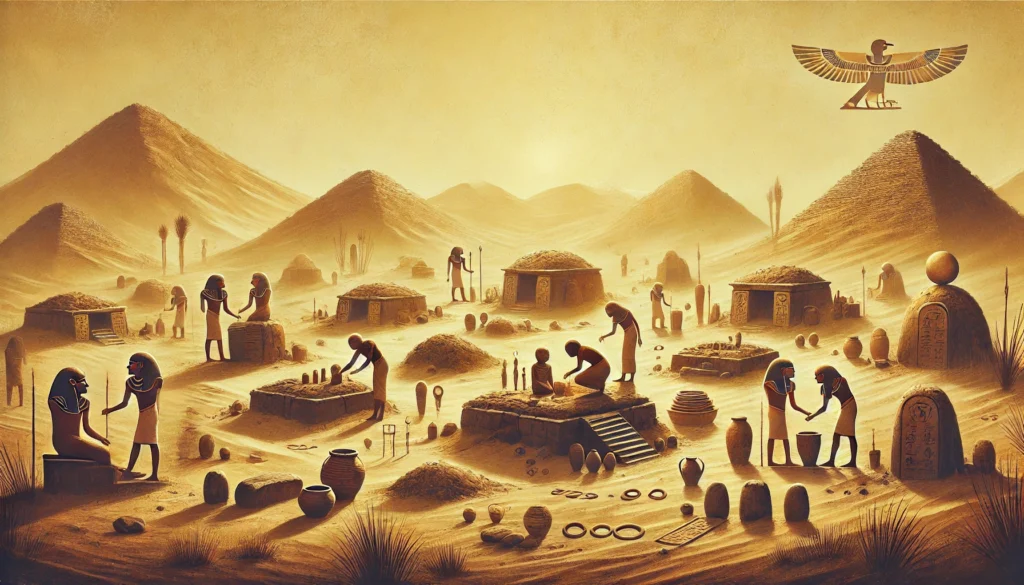The history of “curseology” in Predynastic Egypt—a time before the formation of a unified Egyptian state (circa 6000-3100 BCE)—is rooted in the early religious and supernatural practices of the Nile Valley. Though the formal practice of issuing curses as we know it became more elaborate in later dynasties, there is evidence that suggests a proto-curseology emerged during Predynastic times, involving supernatural beliefs that influenced later Egyptian conceptions of curses, magic, and the afterlife. Here’s an outline of how curse-related practices may have evolved during this period:
1. Belief in Supernatural Forces and Spirits
- Animism and Nature Spirits: Predynastic communities believed in spirits inhabiting animals, rivers, trees, and natural formations. Certain spirits were seen as protective, while others were thought to bring misfortune if offended, potentially laying the foundation for early “curses.”
- Grave Goods and Burials: Burials from this time show that people left offerings, tools, and food with the dead, implying a belief in an afterlife where the deceased had power and influence. Early cemeteries, like those in the Naqada culture, indicate the belief that spirits could linger, bringing blessings or harm to the living.
2. Ritual Protection and Talismanic Magic
- Amulets and Protective Objects: Small objects, such as beads and amulets, found in Predynastic graves suggest a desire to ward off evil or bad fortune. These amulets may represent an early form of protective magic against spiritual harm, evolving into a proto-curseology where certain items warded off specific evils.
- Animal Depictions: Certain animals, like snakes and scorpions, were associated with both harm and protection. This duality hints at an understanding that forces in nature could be controlled, or appeased, to avoid curses.
3. Symbolic Pottery and Iconography
- Carved Motifs on Pottery: Predynastic pottery often included symbolic motifs—such as spirals, animals, and geometric shapes—that scholars believe had ritual significance. These symbols may have been precursors to written spells, with certain designs intended to invoke protection or curse trespassers.
- Vessel Placement in Graves: Vessels and containers positioned in graves might signify offerings to appease the deceased’s spirit or to protect the tomb from desecration, an early form of cursing or deterring intruders.
4. Emergence of Deity Concepts with Protective and Vengeful Powers
- Nekhbet and Wadjet: Early deities like Nekhbet, the vulture goddess of Upper Egypt, and Wadjet, the cobra goddess of Lower Egypt, began to embody protective and punitive powers. These goddesses were later invoked in curses or blessings, showing an early belief that divine forces could bring both good and ill fortune.
- Funerary Steles: Though funerary steles became more common in the Early Dynastic Period, their origins trace back to this time. These markers would later bear curses against tomb violators, a practice possibly inspired by the belief that early spirits could influence the living.
5. Proto-Curse Practices in Community and Tribal Conflicts
- Inter-tribal Rituals: Some early records hint that neighboring tribes or clans had rituals that invoked harm on rivals or trespassers. Rock art and ancient weaponry found near burial sites might represent efforts to curse those who defiled graves or lands, acting as an early psychological deterrent.
- Territorial Markers with Symbolic Warning: Boundary stones and markers with carved images served as territorial warnings. Some scholars suggest these could be interpreted as early curses, warning intruders of supernatural repercussions if boundaries were crossed.
6. Evolution of Mortuary Practices as Proto-Curses
- Protective Wrappings and Burial Positioning: The careful positioning and wrapping of the deceased may indicate beliefs that the dead needed protection or that their spirits should not return to the living world. Improper burial practices were thought to invite malevolent spirits or curses upon the community.
In summary, while formal curse inscriptions and written spells became established in later Egyptian dynasties, the Predynastic period laid the groundwork for “curseology” through proto-magical beliefs, burial practices, protective amulets, and reverence for spirits. Over time, these practices evolved, becoming more elaborate in the Old Kingdom and later periods, where curses were explicitly written and curses against tomb desecrators became more common.
